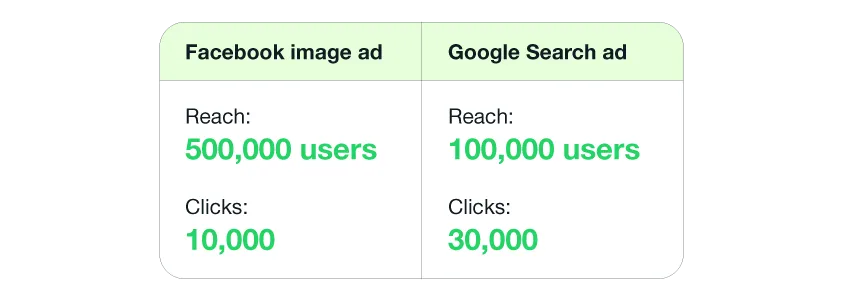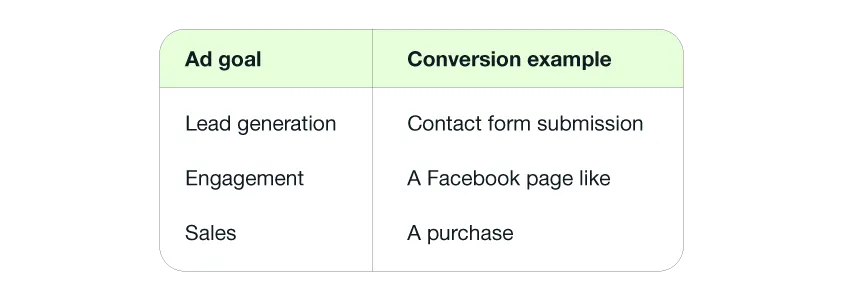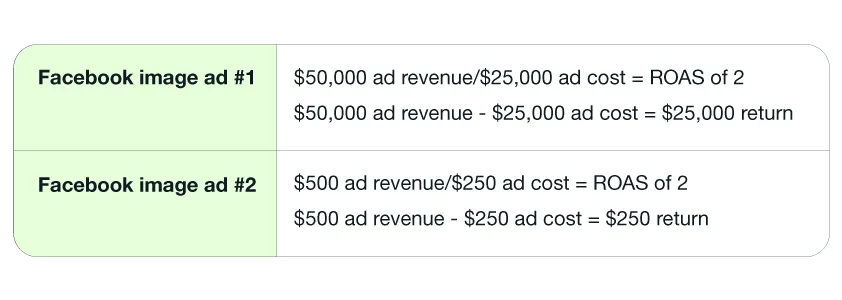
Customers
Are my ads paying off? Track these 6 metrics to find out
June 9, 2023
As an enterprise marketer, you’re spending millions — if not billions — on your online ads. But are the ads you’re focusing on paying off? In our internal research, nearly 40% of marketers didn’t report a positive return with online ads.1
Part of the problem is the complexity of tracking the return of online ads. How do you track the value of an ad that doesn’t lead to a purchase until months later? Even if you understand ad analytics, translating metrics and trends for other departments can lead to a lot of head-scratching.
If you’re gauging the value of your ads, it’s time to take a step back. These 6 metrics will help you and your marketing team begin to answer the core question of ad spend analysis — am I investing in ads that generate positive results at the lowest comparable cost?

Reach
This metric measures how many unique users see your ad. Reach is often confused with impressions, which measures the number of times your ad loads on a screen (including multiple ad appearances for the same user).
Impressions/Unique users = Reach
Reach helps you determine if your ad has a chance of increasing conversions. Your ad won’t drive many sales if few people are actually seeing it.
But this metric alone doesn’t tell you if your ad is engaging or generating sales. Say your Facebook ad reaches 500,000 people, but your Google search ad only reaches 100,000. At the same time, 10,000 people clicked on the Facebook ad, and 30,000 clicked on the Google ad.

The Google ad has a smaller reach, but it’s more engaging than the Facebook ad.
To gauge ad engagement and sales, check your ad’s click-through and conversion rates (more on these metrics later).
What do I do if my ad’s reach is low?
The answer depends on the ad platform you’re using, but generally, you should consider these factors:
- Audience targeting. If your target audience is narrow, the ad platform may struggle to find people who match your criteria. Broaden your ad’s audience by removing “and” from your targeting.2 The ad platform will then match your promotion with people who meet at least one factor, not just users who meet all the criteria.
- Bidding. A low maximum bid — the highest amount you’re willing to pay for your ad — can keep you from winning campaign auctions, which means your ad never reaches your audience. Ad platforms will often label campaigns with a “limited bid” status if you need to increase your amount.
- Budget. A low minimum budget can also keep you from winning auctions, so your ad doesn’t reach many people in your audience. Facebook will sometimes offer recommendations if a minimum budget seems too low in Ad Manager.3 If your audience is over 200,000 people, Facebook will also tell you the budget you need to reach your target group.4

Click-through rate (CTR)
This metric refers to the percentage of times users viewed and clicked on your ad.
(Clicks/Impressions) x 100 = CTR
CTR is a strong indicator of whether your ad is engaging or not. However, it doesn’t tell you whether those clicks are leading to sales. While an ad with broad targeting might receive tons of clicks, it may ultimately result in few conversions because it isn’t relevant for most users.
Say you’re a marketer for a bank, and you release a click-to-message ad on Facebook and a Twitter image ad to encourage new and existing customers to open credit card accounts. The Twitter ad has a CTR of 2%, and the click-to-message ad CTR is 1%.

However, the latter generates twice as many credit card account sign-ups as the former.

The Twitter ad was more engaging, but assuming both campaigns had similar costs, the Facebook click-to-message ad was more valuable.
What should I do if my click-through rate is low?
This metric varies across industries and ad types. Wordstream reports that the average CTR for Facebook ads is .9%,5 .5% for display ads,6 and 6% to 7% for Google search ads.7 If your ad’s CTR falls well below this number, consider these tips:
- Check your CTA. Make sure your ad copy clearly states what you want users to do next, and design a CTA button that stands out against the rest of the promotion. Stick to one CTA per ad to maximize clicks and conversions.
- Adjust your ad copy to be short and captivating, so it’s easy for users to read it and realize why they should click on the promotion. Engage shoppers by asking a question, or consider including a testimonial in your ad to build their trust. In terms of length, check your ad platforms’ recommendations. Facebook, for example, recommends limiting ad copy to 1 to 3 lines.8
- Narrow your audience targeting. If your targeting is broad, you may get fewer clicks relative to your total ad audience size. Narrow the ad’s audience to people most likely to click on your ad.

Messaging conversations started
In our internal study, the most common objective marketers reported was increasing awareness.9 Business messaging platforms are a powerful tool for reaching this goal, as messaging apps have billions of users worldwide. Grow your audience with this channel by running click-to-message ads, which direct consumers to a chat with your brand.
If you use these promotions, track their performance by monitoring “messaging conversations started.” This metric refers to the number of users who started messaging your brand for the first time (or are messaging after 7 days or more of inactivity) after clicking an ad.
Like CTR, “messaging conversations started” helps you gauge whether your ads interest users. And remember, a person who engages in a messaging conversation isn’t necessarily a likely buyer.
Say you’re a marketer for a car brand, and you create a click-to-message Instagram ad about your latest model. The promotion emphasizes that payments could be as low as $150 per month. Within a week of posting the ad, 1,000 potential customers click on it and message your brand to ask questions about the new car model.
But through these chats, your team realizes that most shoppers aren’t willing to pay the down payment needed for the $150 per month payment plan. Of the 1,000 people who click on the ad, 50 people set up appointments at their local dealership to check out the car.
1,000 messaging conversations started → 50 dealership appointments
The beauty of click-to-message ads is that your team spends little to no time qualifying leads. Instead of spending hours on the phone with unsure car shoppers, you can set up automated chat questions to determine who is a serious buyer in minutes.
What should I do if my ad’s “messaging conversations started” rate is low?
Users have to click your ad’s CTA button to start a chat with your brand. So to increase your ad’s messaging conversations started rate, follow the tips listed in the above click-through-rate section.
Beyond these tactics, try to win clicks from consumers by creating a positive, consistent messaging experience that makes them want to chat with your business again. Consider these tips:
- Set up automated conversation flows. Create message templates with button-based responses, and shoppers can have quick, convenient conversations with your chatbots.
- Let consumers choose between chatbots and agents. People may not want a bot as their only option, especially if they have a complex or urgent problem. Set up your chatbots to always ask if shoppers want to chat with an agent. If your team isn’t available 24/7, design your chatbot to share your support hours so customers know when to expect a response.
- Integrate your messaging platform with your tech stack, so your agents and chatbots can easily pull existing customer details and shoppers don’t have to repeat themselves. For example, a Turkish online fashion retailer set up a chatbot that can access customers’ profile data. If a shopper wants to buy a product in the chat, the bot can complete the purchase with their stored payment information.

Click conversion rate
This metric represents the percentage of shoppers who completed a set action after clicking on your promotion.
(Conversions/Clicks) x 100 = Click conversion rate
The actions that count as conversions depend on your ad’s goal. Here are a few examples of conversions based on different ad objectives.

Your ad’s conversion rate tells you how effective your promotion is relative to how many people click on it. However, it doesn’t represent the number of conversions an ad generates.
Say you have an Instagram video ad and a Google search ad that both have the goal of sales. The former’s conversion rate is 1%, while the latter is 2%. But despite having a lower rate, the Instagram video ad generates twice as many conversions — 100 sales compared to 50.

What should I do if my ad’s click conversion rate is low?
The answer depends on your ad’s objective — increasing lead contact form submissions, getting Facebook page likes, and boosting sales all involve different tactics. Generally though, you can boost your conversion rate by considering your ad’s targeting and destination.
- Use retargeting to send your ad to people who have shown interest in your brand. People will be more likely to share their contact information or make a purchase if they’re already familiar with your company.
- Consider whether your ad’s destination could offer a better customer experience. If your ad takes people to a contact form, how many fields do they have to fill out? If it’s a click-to-message ad, how long does a shopper have to wait before getting a reply? Test variations of your ad’s destination to determine what changes minimize friction and lead to the most conversions.

Cost per acquisition (CPA)
This metric represents the cost of getting a shopper to make their first purchase after clicking an ad.
Ad spend/New customers attributed to the ad= Cost per acquisition
Cost per acquisition is necessary for gauging the value of an ad, but the metric alone doesn’t tell you whether a promotion is cost-effective. You also have to consider your customers’ lifetime value (LTV). Generally, the recommended ratio between LTV and CPA is 3 to 1.10
Say you’re a marketer for a beauty brand, and you spend $10,000 on Facebook video ads over a quarter. These promotions generate 200 new customers, so your CPA for Facebook video ads is $50.
$10,000 ad spend/200 new customers = $50 cost per acquisition
However, your customer LTV is only $75 — giving you an LTV: CPA ratio of 1.5 to 1, which is well under the 3:1 benchmark.
$75 LTV/$50 CPA = 1.5:1
A $50 CPA might be good for brands with more expensive products, but it likely won’t be sustainable for this beauty brand.
What do I do if my ad’s CPA is too high?
To lower your ad’s CPA, you’ll need to look at the two factors that go into this metric: cost and sale conversions.
- Lower your ad’s minimum budget based on your ad platform’s recommendations. Facebook has different guidelines3 for changing minimum budgets based on various factors, like when advertisers get charged and their ad’s goals.If your budget seems reasonable given your ad platform’s guidance, the ad type or channel might be too competitive or a poor fit for your audience.
- Increase acquisitions based on the conversion rate tips in the last section. The tip about creating a high-quality ad destination is especially important when you’re trying to win sales. Think about the customer’s journey from your ad to placing an order. Is there any step that could be smoother for the shopper?
As you reduce this metric, remember that a low CPA isn’t always good — especially if you’re trying to grow your business. You could have a CPA of $10, but will that be enough to bring in any new buyers? Invest enough in your ads to win a sustainable number of customers.

Return on ad spend (ROAS)
This metric refers to the revenue you earn from an ad after accounting for ad costs.
Ad revenue/Ad costs = ROAS
Your ROAS tells you how much you earn for every dollar spent on advertising. For example, a ROAS of 2 means you earn $2 for every dollar spent on a promotion.
This metric gives you a clear snapshot of whether your ad spend is paying off in the short term, so it’s especially helpful for sales-driven promotions. However, ROAS doesn’t tell you what the return of an ad is — it just tells you the ratio.
Say you have two Facebook image ads, and they both have a ROAS of 2. The campaigns could also have wildly different budgets, revenue, and returns.

ROAS also only reflects short-term revenue, as ad platforms typically only track sales within a few days of someone clicking your ad. Consider your business model and customer journey to gauge the long-term value of your promotions, too.
Say you’re a marketer for a subscription ecommerce brand. You might think an ad only led a customer to one $50 purchase for a monthly box. But when you check a year later, you realize the ad actually led to $600 in revenue thanks to the shopper’s 12 monthly payments.
$50 monthly subscription x 12 months = $600 in revenue
How do I increase my ad’s ROAS?
To boost an ad’s ROAS, you have to lower its costs or increase its sales conversions (or both). Review the tips for increasing conversions and lowering cost per acquisition in the sections above.
Along with maximizing ad revenue and minimizing costs, consider setting a ROAS goal11 in your ad platform. This feature tells platforms to only use your ad spend when it can deliver a return close to your set goal.
A ROAS goal is great if you don’t have much flexibility around your ad returns. However, it can make it difficult for brands to fully use their ad budget because their ad platform can’t find enough opportunities to meet the ROAS goal.
If you want to maximize your ad’s value and fully spend your budget, you can tell your ad platform to maximize your promotion’s value instead.12 This feature tells platforms to fully use your ad budget in a way that will encourage high-value purchases.

Build short-term and long-term value with click-to-message ads
As the ROAS metric shows, marketers often only consider short periods when tracking ad returns. Create a sustainable foundation for your marketing by considering both ads that give you these short-term wins and ads that help you build and nurture long-term customer relationships.
Click-to-message ads fall into both categories. The promotions show consumers they can purchase from messaging apps, a channel they know and love. At the same time, these ads create opportunities for brands to regularly check in with customers and make sure they’re happy.
Learn more about creating click-to-message ads in this blog post on Getting Value from WhatsApp Messaging.
Best practice recommendations solely to help inform ad campaign strategies; not intended as a warranty or guarantee of results to be achieved. Marketing outcomes depend on a variety of factors and will vary.